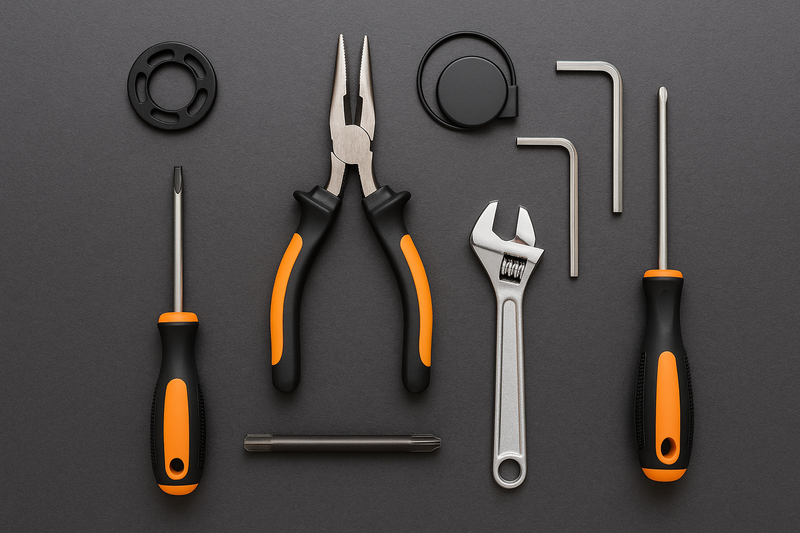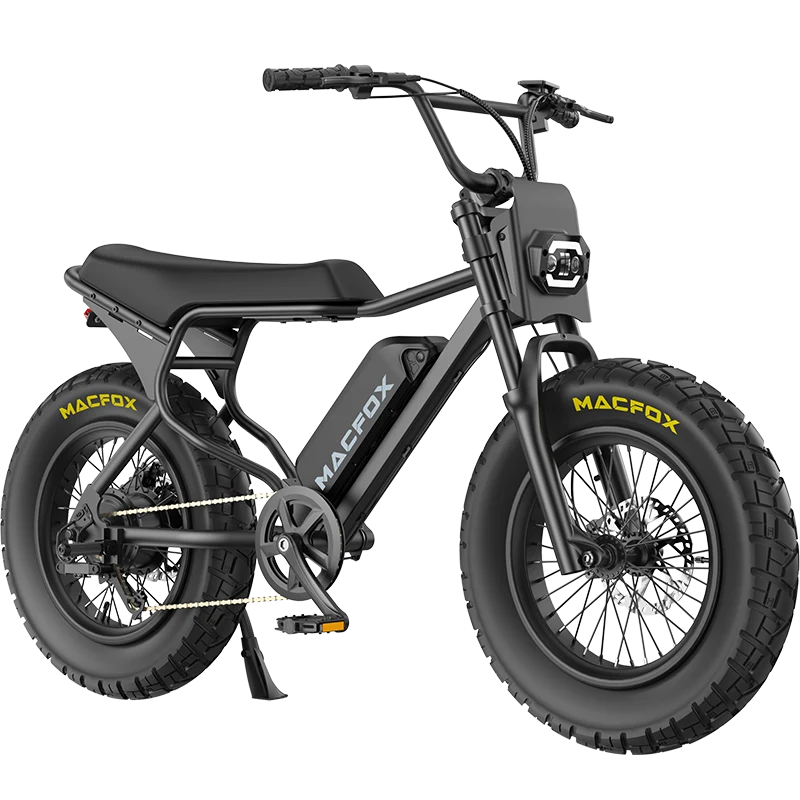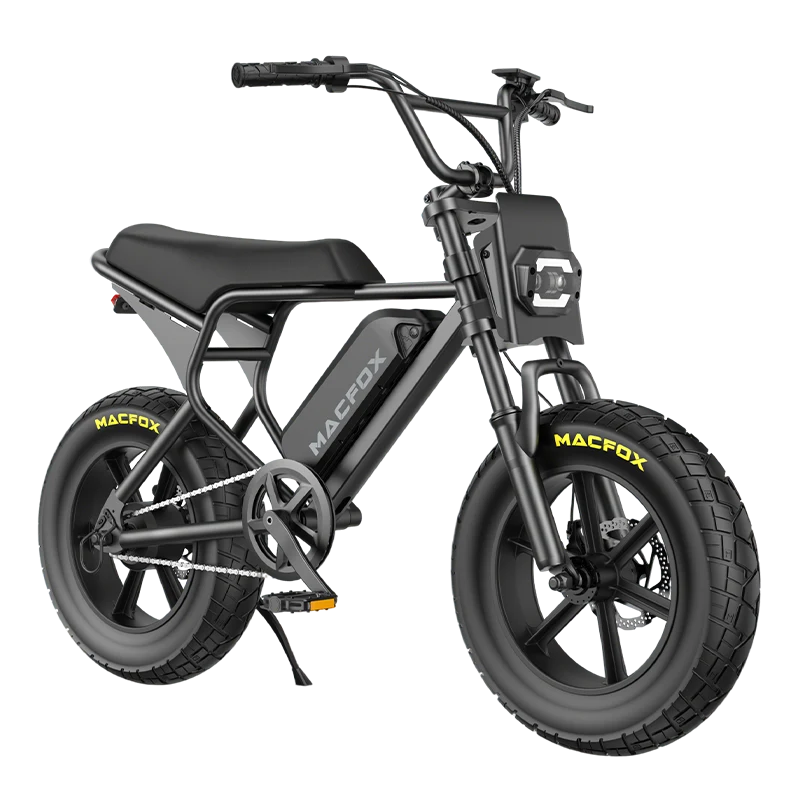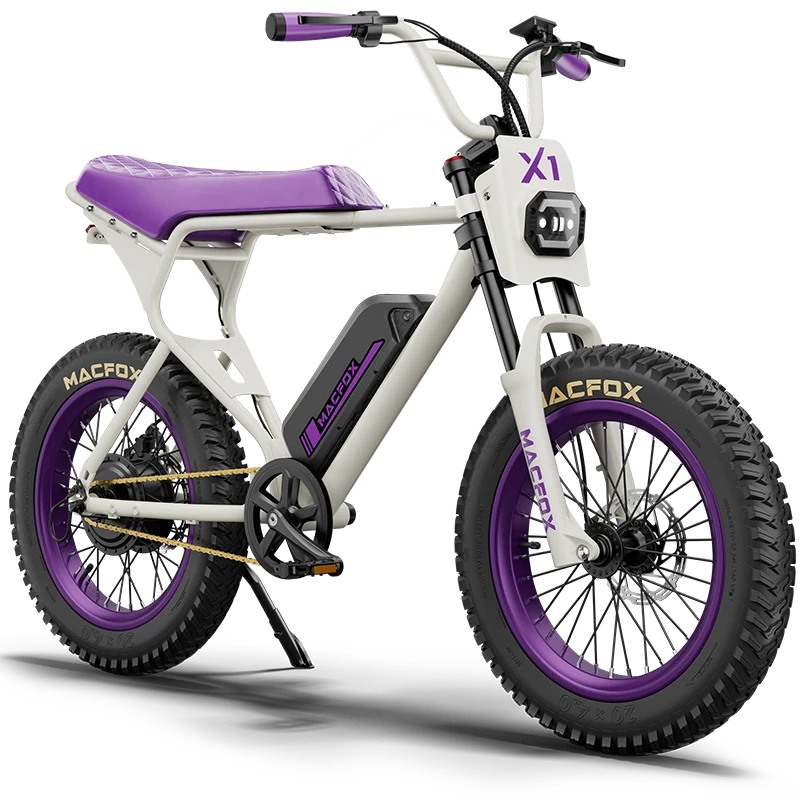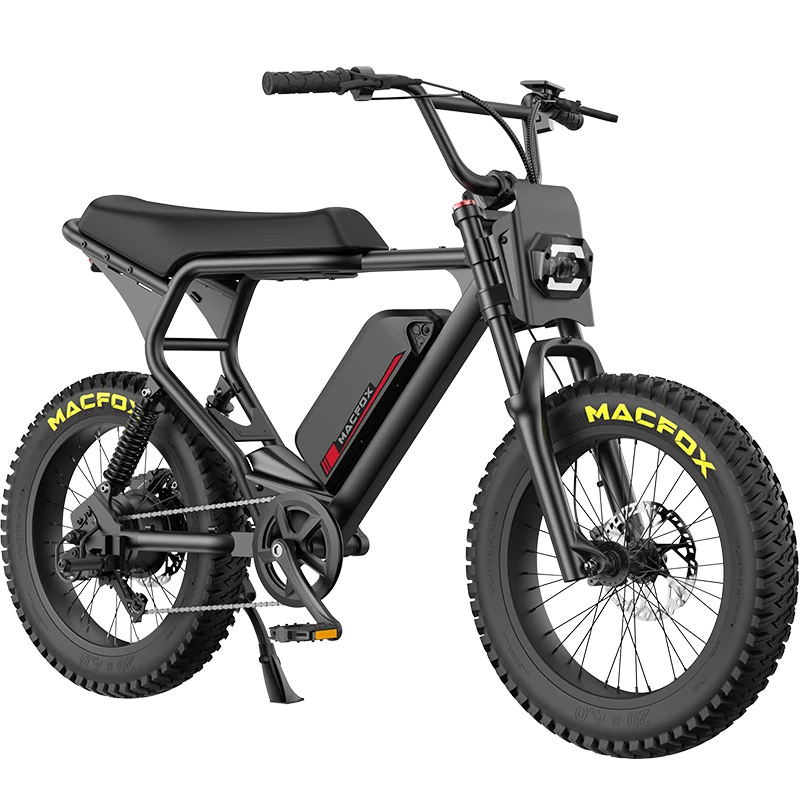Replacing a cadence sensor on your electric bike is a manageable DIY task that can restore your pedal assist performance.
When your e-bike’s motor stops kicking in while you pedal, a faulty or misaligned sensor is often the culprit.
In this guide, we’ll walk through what a cadence sensor does, signs it needs replacement, the tools required, and step-by-step instructions to replace a cadence sensor.
With a few basic tools and careful steps, you can get your commuter ebike’s pedal assist working smoothly again, saving time and money on repairs.
Related: Cadence Sensor Troubleshooting: How to Fix Pedal Assist on Your E-Bike
Quick Summary: Replacing a Cadence Sensor (Step-by-Step)
-
Turn off power and remove the battery: Always shut down the e-bike and disconnect its battery before any work for safety. This prevents accidental short circuits or motor engagement while you work.
-
Locate the cadence sensor and its wiring: The sensor is usually near the crank or bottom bracket area, facing a magnet disc on the crank arm.
Trace the sensor’s wire to where it plugs into the controller or wiring harness, and unplug it. Cut any zip-ties as needed to free the cable.
-
Remove components to access the sensor: Use an 8mm Allen wrench to remove the crank bolt, then a crank puller tool to take off the crank arm (and pedal, if necessary) for better access.
On some bikes with an internal sensor, you may need to unscrew the bottom bracket cup using a bottom bracket tool. For external sensors, simply unscrew or unclip the sensor unit from the frame.
-
Take out the old sensor and magnet ring: Gently pull the old cadence sensor out of its mount. If there’s a magnet ring on the crank spindle, slide it off as well. In some designs, the sensor is a small round unit pressed into the bottom bracket area – remove it carefully to avoid damaging the wire.
-
Install the new cadence sensor: Mount the replacement sensor where the old one sat, feeding its cable along the same route. If there’s a magnet disc, install the new one on the crank arm or spindle.
Ensure the sensor’s orientation matches the old unit (the side with the electronics should face the magnet ring). The magnet disc should pass very close to the sensor (about 1–3 mm gap) for proper detection.
-
Reconnect wiring and reassemble: Plug the new sensor’s connector into the controller or harness, making sure the connection is secure. Reattach the bottom bracket cup if you removed it, greasing the threads and tightening appropriately.
Reinstall the crank arm (and pedal), tightening all bolts firmly. Replace any covers or panels and use zip ties to secure the sensor cable out of the way.
-
Test the pedal assist: Reinsert the battery and power on the bike. Lift the rear wheel (or use a bike stand) and pedal to see if the motor now engages. You can also check any sensor indicator light if present (many sensors have a small LED that blinks when magnets pass).
Take a short test ride to confirm the pedal assist kicks in reliably. If the motor still doesn’t respond to pedaling, double-check the sensor alignment and connections.
Understanding the Cadence Sensor and Its Role
A cadence sensor is a key component of an e-bike’s Pedal Assist System (PAS). It uses a magnet and sensor arrangement to detect when you are pedaling and how fast.
Typically, a magnet ring with multiple magnets is attached to the crank, and a sensor (a small electronic unit with a Hall effect sensor) is mounted on the bike frame near that ring.
As you pedal, the magnets pass by the sensor, triggering it to send signals to the bike’s controller indicating pedal motion.
If the controller “sees” that you’re pedaling, it activates the motor to provide assistance. This cadence-based assist functions in an on/off fashion – if you are pedaling (and have an assist level selected), the motor will engage, and it stops shortly after you stop pedaling.
Cadence sensors are common on many hub-motor e-bikes because they are simple, reliable, and cost-effective.
Related: Common Wiring Problems and Troubleshooting Guide for Rear-Wheel Hub Motor E-Bikes
(This differs from more advanced torque sensors, which measure how hard you press on the pedals for a proportional assist.)
A properly working cadence sensor makes your ride feel seamless: you pedal lightly and the bike’s motor smoothly adds power.
However, if the sensor fails or goes out of alignment, the bike will behave like a normal bicycle with no assist, drastically changing your riding experience.
When to Replace a Cadence Sensor: Signs of a Faulty Sensor
How do you know if the cadence sensor needs replacing? There are a few telltale symptoms of a bad or failing sensor in an electric bike’s pedal assist system:
No Motor Assist When Pedaling
You pedal, but the motor doesn’t kick in at all, and the bike provides no assistance. The bike feels “dead” in pedal assist mode, acting like a regular bicycle with only human power.
This is a classic sign that the PAS sensor isn’t detecting your pedal movement.
If your display shows you’re in an assist level and there’s still no power, the cadence sensor or its connection is likely at fault.
One quick diagnostic tip: if your e-bike has a throttle, check whether the throttle still works. A working throttle combined with no pedal assist almost always points to a pedal sensor problem.
Intermittent or Erratic Assist
The motor assist cuts in and out unpredictably while you pedal. For example, sometimes you get power and other times you don’t, or the assist starts then suddenly stops even though you continue pedaling.
This jerky on/off behavior often indicates a loose sensor wire connection or a misaligned sensor and magnet ring. A magnet disc that’s wobbling on its spindle or a sensor cable with an intermittent break can cause these symptoms.
Delayed Engagement or Lag
All cadence-based systems have a small natural delay (usually a second or two) before the motor kicks in. But if you notice an unusually long lag or you must pedal several rotations before assist engages, it might mean the sensor is barely detecting the magnets.
A sensor positioned too far from the magnet ring or a weakened magnet can cause this behavior. Essentially, the system isn’t “seeing” your pedaling promptly.
No Error Codes Displayed
In many cases, a failing cadence sensor won’t trigger a specific error message on the display. The bike simply won’t provide assist, yet everything else may appear normal (battery level, throttle, lights, etc.).
You might not see any fault code while pedal assist refuses to work. This can be confusing, because other issues usually show some error or affect other functions.
Generally, if only the pedal assist is non-functional (and your throttle and battery are fine), the cadence sensor is the prime suspect.
These symptoms highlight when a sensor is likely bad. Before jumping to replacement, it’s wise to inspect the sensor setup: sometimes the cause is a misalignment or dirt rather than a truly dead sensor.
The cadence sensor must be extremely close to the magnet disc (usually within a few millimeters) to read correctly. If that gap widens or the disc is knocked out of line, the sensor may stop registering pedaling.
Likewise, check that the sensor’s cable is firmly connected and not damaged. However, if everything is aligned and clean and you still experience no or inconsistent assist, the sensor unit could be defective.
Fortunately, cadence sensor units are generally not expensive and are relatively easy to swap out – often it’s as simple as unplugging the old sensor and plugging in a new one.
Gathering Tools and Preparing Your Bike

Preparation is key for a smooth cadence sensor replacement. Before you start, make sure you have the right tools and have taken safety precautions.
Safety first: Ensure the bike is completely powered off. Remove the battery or switch it off and lock it (if your bike uses a keyed lock) to avoid any power flow.
This step is crucial to prevent electrical shorts or accidental motor startup while you work. Also, if your e-bike has a power switch on the display or a main fuse, turn those off as well.
It’s a good idea to have the bike on a stable repair stand or to flip the bike upside down (resting on the handlebars and saddle) so you can freely rotate the pedals and wheel.
Tools you’ll need: Replacing a cadence sensor may require a few bicycle tools, especially if the sensor is integrated near the bottom bracket. Common tools include:
-
Allen wrenches (hex keys): Most bikes use an 8 mm Allen key to remove the crank arm bolts. You might also need smaller hex keys or screwdrivers if your sensor is held by a small bracket or cover.
-
Pedal wrench (15 mm) or adjustable wrench: If you need to remove the pedals for easier crank removal, a thin 15 mm pedal wrench is useful. (Remember: the left pedal loosens by clockwise rotation, and the right pedal by counterclockwise.)
-
Crank puller tool: Many e-bikes use a square taper or splined crank arm that requires a crank puller to remove the crank from the bottom bracket spindle. This tool threads into the crank and lets you pop the crank arm off once the bolt is removed.
-
Bottom bracket tool: If your cadence sensor is built into the bottom bracket area, you may need a bottom bracket removal tool to unscrew the bottom bracket cups.
Some sensors sit right behind the left-side bottom bracket cup, so that cup must be removed to extract the sensor.
Bottom bracket tools are usually specific to the type of bottom bracket (for example, a Park Tool BBT-22 or BBT-32 for common cartridge BBs).
-
Replacement sensor kit: Of course, have your new cadence sensor unit on hand. Ideally it should be the correct type for your bike’s system (compatible connector and similar magnet count). Many cadence sensor kits come with the sensor, magnet disc, and connector attached.
-
Cable ties and cutters: New zip ties for securing the sensor wire neatly after installation, and wire cutters or scissors to trim old ties or packaging.
-
Miscellaneous: A small flat screwdriver or Torx driver (if your bike uses Torx bolts on crank or covers), a flashlight to see the sensor area, and some grease to re-grease the bottom bracket threads or crank bolt upon reassembly.
Wearing gloves can keep your hands clean, and a rag is handy for cleaning any dirt around the bottom bracket.
With tools ready, make sure you also have a clean workspace.
Keep track of small parts like bolts, spacers, or the little rubber O-ring that some cadence sensors have to seal out dirt (for instance, certain sensors have an O-ring on the spindle interface – be careful not to lose it when you remove the old sensor).
Having a parts tray or even a small cup for bolts can be helpful.
Preparation steps:
-
Power down: As mentioned, turn off the bike and take out the battery. Double-check the system is fully unpowered.
-
Position the bike: Mount it on a repair stand or prop it securely. You’ll be working near the crank area, so ensure you have room to maneuver tools.
-
Remove any covers or guards: Some e-bikes have a plastic cover over the controller or bottom bracket area. Remove these if they block access to the sensor or wiring. They may be held by a few small screws.
Also, if the chainring or crank has a guard or chain cover that’s in the way, take that off as needed.
-
Inspect the setup: Identify your cadence sensor – on many hub-motor bikes, you’ll see a disc with magnets on the crank arm (usually left side) and a small sensor module fixed to the frame near that disc.
On other models, the sensor might be internal, detectable only by a wire going into the frame near the bottom bracket. By understanding the layout, you can plan which parts to remove first.
Once everything is prepared and you understand your bike’s configuration, you’re ready to proceed with the actual replacement.
Step-by-Step Guide: How to Replace the Cadence Sensor
Now we’ll dive into the detailed process of removing the old sensor and installing the new one.
This guide covers the general procedure that will apply to most e-bikes, whether they use an external magnet ring sensor or an integrated bottom bracket sensor.
Adjust the steps as needed for your specific bike model:
Step 1: Disconnect the Sensor From the Controller.
Before unmounting the sensor, disconnect its wiring. Find where the cadence sensor’s cable plugs into the bike’s wiring harness or controller.
Often, there’s a small two-pin or three-pin connector a short distance from the sensor (sometimes tucked under the frame).
Unplug this connector by pulling it apart (avoid pulling on the wires; grasp the plugs). You might need to cut a few zip-ties to free the cable leading to this plug.
This disconnection ensures you can remove the sensor without twisting or straining the wires. It’s also a good opportunity to inspect the connector for corrosion or damage, and clean it if needed.
Related: How Hall Sensors Power Your E-Bike: Benefits, Failures, and DIY Repairs
Step 2: Remove the Pedal Crank (If Required).
In many cases, the left crank arm needs to come off to access the sensor and magnet ring. Use your 8 mm Allen wrench to loosen the crank bolt in the center of the crank arm (turn it counterclockwise to remove).
Once the bolt is out, thread your crank puller tool into the crank arm’s threads. Make sure it’s fully threaded by hand before using a wrench – if it’s not well-seated, you can strip the crank threads.
After it’s threaded in, tighten the crank puller’s inner bolt to press against the bottom bracket spindle; this will pop the crank arm off its square taper or spline.
Remove the left crank arm completely. (Tip: If your pedals were making it hard to maneuver the crank puller, remove the pedal from the crank arm first using the 15 mm pedal wrench.)
For bikes with an external cadence sensor (magnet disc on the crank), usually only the left crank needs removal.
For some internal sensors, you might also have to remove the right crank and possibly the chainring to fully get the bottom bracket out.
Follow the same process for the right side if needed (note: right side crank bolts also loosen counterclockwise, but the right crank may be attached to the chainring and come off as one unit).
Step 3: Access the Sensor and Magnet Ring
With the crank arm off, you can now remove the magnet ring (if your bike has one mounted on the spindle).
The magnet disc often is a plastic ring that might slide right off the spindle once the crank is gone.
Some are a two-piece design that clip together around the spindle. Take it off carefully and set it aside. You will replace it if your new sensor kit includes a new magnet disc (it’s often recommended to use the new one provided).
Now, focus on the sensor itself. If it’s an external type mounted to the bike frame (for example, a small black plastic piece near the bottom bracket), it might be attached with a screw or just clipped in place.
Remove any mounting screw or gently pry the sensor unit off its bracket. If the sensor is integrated inside the bottom bracket shell (common on some newer e-bikes), you will need to remove the bottom bracket to get it out. For an integrated sensor:
-
Use your bottom bracket tool on the non-drive (left) side bottom bracket cup. Turn it counterclockwise to unscrew the left cup (most left cups are standard right-hand threads).
Once the left cup is out, you can often see or feel the sensor unit. It may sit in a slot or just be held by the pressure of the bottom bracket.
-
Carefully pull the sensor out of the frame’s bottom bracket hole, feeding its wire out without yanking. If the right side cup doesn’t need removal, leave it in place (as it may have a reverse thread).
In some designs, the sensor has small splines or tabs that fit into notches in the BB cup – note their position for reassembly.For either type, remove the old sensor unit completely from the bike once it’s free.
Keep note of any shims or rubber grommets that might have been there for alignment or sealing.
Step 4: Install the new cadence sensor unit

Take your new sensor and slide it into position where the old one was. For an external sensor, you might attach it to the frame mount or bracket (usually near the left side of the bottom bracket).
Ensure it’s oriented the same way the old sensor was, typically with its sensing face toward where the magnet ring will be. If there was a particular groove or tab alignment (like those splines that engage the bottom bracket cup), line those up correctly.
Gently route the sensor’s cable through the frame or along the frame following the original path. It’s important to avoid pinching the wire; it should have a smooth path out of the bottom bracket area without getting snagged when you reinstall the bottom bracket cup.
For internal sensors, once the sensor is seated properly (often two small ridges on the sensor casing will slot into the removed BB cup’s notches), begin threading the left bottom bracket cup back in.
Thread it by hand first to avoid cross-threading; it should go in smoothly. Tighten the cup securely with the bottom bracket tool (remember, left side tightens clockwise for standard BBs; right side would tighten counterclockwise if you removed it).
As you tighten, ensure the sensor stays in its correct position and the cable isn’t twisting. The sensor’s two outer splines should engage the notches on the BB cup so it doesn’t spin when the bike is in use.
If your e-bike uses an external sensor, installation is simpler: you’ll just secure the sensor to its mount (screw it back or snap it in) and make sure it’s positioned close enough to where the magnet disc will rotate.
Now reinstall the magnet ring onto the crank or spindle. Push it all the way in so it sits close to the sensor.
Typically, you want only a gap of 1–3 mm between the sensor and magnet ring – very close, but not touching even when things flex.
This gap is crucial: too far and the sensor won’t detect the magnets, too close and they might rub. If the magnet ring has an arrow or marking for direction, orient it correctly (usually the writing faces outwards).
An e-bike cadence sensor (right) and magnet disc (left) must be aligned with a small gap between them for proper operation.
When installing the new sensor, ensure the magnet ring is about 1–3 mm away from the sensor face for reliable pedal assist activation.
Step 5: Reconnect and Secure Wiring
Once the new sensor and magnet are in place, plug the sensor’s connector back into the controller wiring.
Line up any arrows or keyed shapes on the connectors and press them together firmly until fully seated (most e-bike connectors are weather-sealed and require a solid push to connect).
If the plug has a locking collar, tighten it. Use new zip ties to attach the sensor cable along the frame, following the same route as before.
Make sure the cable has enough slack at the handlebars or frame pivot points (if a folding bike or suspension) so it won’t snag or stretch, but not so much slack that it can dangle into moving parts.
Trim off excess zip tie ends for a clean finish.
Related: Common Wiring Problems and Troubleshooting Guide for Rear-Wheel Hub Motor E-Bikes
Step 6: Reassemble the Drivetrain Components
Time to put everything back. If you removed the bottom bracket, double-check both sides are tightened and any spacers are replaced correctly. Now reinstall the crank arms:
-
Slide the left crank arm back onto the bottom bracket spindle in the exact orientation (usually opposite the right crank by 180°). Hand-thread the 8 mm crank bolt and then tighten it securely with the Allen wrench.
Crank bolts need to be quite snug (often around 30–40 Nm torque) to hold the crank arm on without wobble – if you have a torque wrench, even better.
-
Reattach the right side crank and pedal (if you had removed them). Remember to grease pedal threads and tighten them in the correct direction (right pedal clockwise to tighten, left pedal counterclockwise to tighten).
-
If your chain was disturbed or removed, put it back on the chainring. Also reattach any chain guard or cover that was removed.
-
Replace the controller cover or any panel that you opened to access wiring, securing all screws.
Before moving on, do a quick visual inspection: The new cadence sensor should be firmly in place, its cable neatly secured, the magnet disc properly aligned (small gap) with the sensor, and all bolts tightened.
Step 7: Test the New Sensor’s Functionality
Reinstall the battery on the bike and power it up.
While the bike is still on the stand (or wheels off ground), gently rotate the pedals. Watch the rear wheel or listen for the motor: it should start spinning the wheel as you pedal (if you’re in a normal assist mode).
If your sensor or display has an indicator light for PAS, check that it lights or blinks when you turn the pedals.
A blinking light on the sensor with each pedal rotation means the sensor is detecting the magnets properly.
If the motor engages, congratulations – your new sensor is working!
Go for a short ride in a safe, flat area. Test that the assist comes on and cuts off appropriately when you stop pedaling.
Try different assist levels to ensure the controller responds to pedaling at all settings. The bike should feel back to normal, giving you consistent help as you pedal.
Troubleshooting after installation: If you find that there is still no pedal assist after replacement, or it’s erratic, consider these checks:
-
Sensor alignment: Double-check that the gap between sensor and magnet disc is small (around 1–3 mm) and that the magnets face the sensor.
Even a slight misalignment can prevent detection. Adjust the sensor’s position if possible, or add a thin spacer behind the magnet ring to bring magnets closer.
-
Connections: Make sure the sensor’s connector is fully plugged in and not reversed. Inspect the cable for any pinched spots from reassembly. A partially connected plug or pinched wire can mimic a bad sensor.
-
Assist settings: Ensure your display is actually in pedal assist mode (not level 0). Also verify that brake cutoff switches aren’t stuck (a brake sensor stuck “on” will override pedal assist).
-
Defective part: Though rare, a new sensor could potentially be bad out of the box. If you have a multimeter or your display’s diagnostics, you could test the sensor signal, but the easiest might be trying another new sensor if available.
Also consider if the issue might lie elsewhere (controller or wiring), especially if a second sensor doesn’t fix it.
Most of the time, a fresh sensor and proper alignment solve the problem.
Once you get it working, you’ll immediately feel the motor responding to your pedaling efforts once again, making your e-bike commute or ride as easy as it should be.
Post-Replacement Tips and Maintenance
After successfully replacing the cadence sensor, a few maintenance tips can help ensure your pedal assist continues to work reliably:
Keep the Sensor Area Clean
Periodically check around the bottom bracket and crank for dirt, mud, or debris. Grime can build up and possibly interfere with the magnet signal or even push the magnet ring out of alignment.
Wipe down the sensor and magnet ring with a cloth after muddy rides. A clean sensor is a happy sensor – even a thin layer of dirt can weaken the magnetic detection if it builds up.
Check Alignment Regularly
Every so often, glance to ensure the magnet disc hasn’t drifted away from the sensor.
It should remain close (but not touching). If you ever hear a rubbing noise or tick each pedal stroke, the magnet ring might be contacting the sensor – adjust it to maintain a small gap.
Conversely, if you experience intermittent assist again, inspect if the ring has loosened or slid outward on the crank spindle.
Simply pushing it back in place (and sometimes adding a drop of removable threadlocker or a thin shim if it keeps sliding) can fix the issue.
Secure Wiring
Make sure the sensor’s cable is not dangling loosely where it could snag or get damaged. Use zip ties appropriately but not so tight that they pinch the wire.
Leave a little slack at joints (like where the frame folds or the handlebars turn) to avoid straining the cable.
Vibration from riding can sometimes loosen connectors, so ensure the PAS plug connection is snug. If you ride frequently on rough roads, it’s worth checking connectors during routine maintenance.
Avoid Water Damage
While sensors are generally sealed, try not to directly spray the sensor area with high-pressure water (for example, from a hose) and avoid submerging that part of the bike.
If you must wash the bike, gentle rinsing is fine, but afterward ensure the connector is dry. A bit of dielectric grease on the connector pins can help ward off corrosion if you often ride in wet conditions.
Be Gentle with Pedals and Cranks
The cadence sensor can sometimes be damaged by impacts – for instance, if the bike falls over on its side or you hit a stump or curb hard with the crank area.
Such impacts can crack the sensor or dislodge the magnet disc. If an accident happens, it’s worth inspecting the sensor afterward. Re-align or tighten any loose parts as needed. Replacing a cracked magnet disc or sensor early can save you from intermittent assist problems later.
By following these tips, you’ll extend the life of your new sensor and enjoy consistent pedal assist on all your rides.
The cadence sensor is a small device, but it has a big impact on the e-biking experience – keeping it in good shape means your daily commute or weekend adventure will stay powered and fun.
Final Thoughts
Replacing a cadence sensor is a task well within reach for DIY enthusiasts, even if you’re relatively new to e-bike maintenance.
Taking the time to do it properly ensures your electric commuter vehicle stays reliable and responsive.
In summary, identify the symptoms of a bad sensor, prepare with the right tools, and follow a step-by-step approach to swap in a new sensor.
By following this comprehensive guide, you’ve learned how to confidently replace a cadence sensor and maintain the pedal assist system. Safe riding and happy tinkering!


